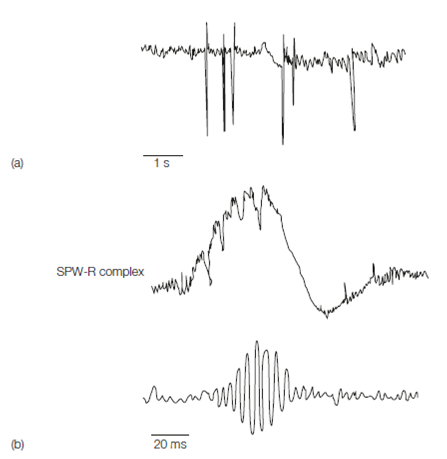Memory and sleep
Some memory consolidation appears to happen during sleep. Slow-wave sleep seems to be important for declarative memory of events and facts, whilst REM sleep may be needed for emotional learning and procedural learning.
Episodic information is rapidly stored in the recurrent connections in CA3 and then incorporated into neocortical LTM. It has been proposed that the transfer is mediated by coherent spiking of hippocampal neurons during high-frequency sharp wave or ripple complexes (SPW-Rs) which occur during awake immobility and slow-wave sleep in Figure. During SPW-Rs, sequential activation of place cells which occurred during spatial exploration is replayed at a faster rate. SPW–Rs are generated within CA3, in response to Long Term P induction there, and spread to CA1 then entorhinal cortex. They increase the excitability of hippocampal cells and their neocortical goals dramatically. Most CA1 pyramidal cells are powerfully inhibited during SPW–Rs, but the small number of active cells, those encoding the new spatial learning; increase their firing frequency to be in synchrony with the ripple component of SPW-R spikes. Firing of neocortical neurons through SPW-Rs during the long-lasting depolarizations of slow-wave sleep activity induces LTP which allows the neocortical connections to be re-specified.

Figure: Hippocampal sharp wave/ripple complexes (SPW-Rs) in CAI. (a) Series of SPW- Rs seen during awake immobility in a rat after a period of exploration, (b) Single SPW-R complex with (below) filtered recording to show 150–300 Hz ripples.
The better recall of emotionally salient memories after particularly REM-rich sleep in humans suggests that REM sleep is also important for emotional memory:
- REM sleep is rise in stress commonly and specifically in major depression, bereavement, and post-traumatic stress disorder.
- Brain imaging describes in which during REM sleep although brain activity is reduced in the dor solateral prefrontal cortex part of the executive thalamocortical–basal ganglia circuit included in working memory, planning, and problem solving it is increased in the limbic cortex and the amygdala.
One difficulty with the REM sleep hypothesis of sleep is which monoamine oxidase inhibitors used for the treatment of depression severely decrease the proportion of REM sleep. Moreover, there is no evidence which patients treated with these agents have any memory deficits even with long-term use.